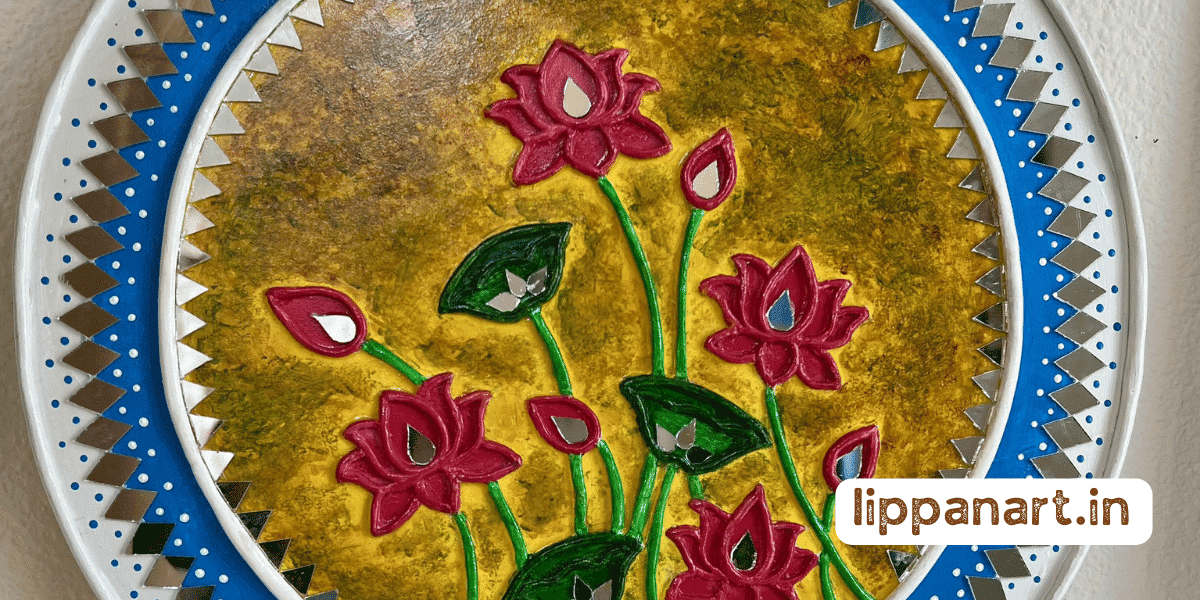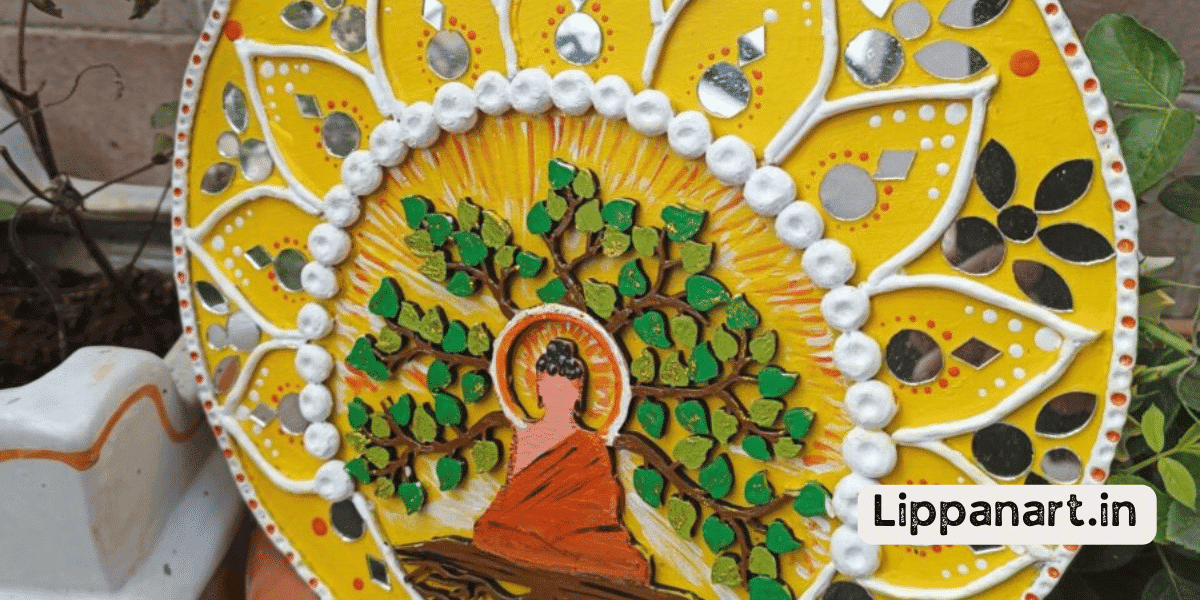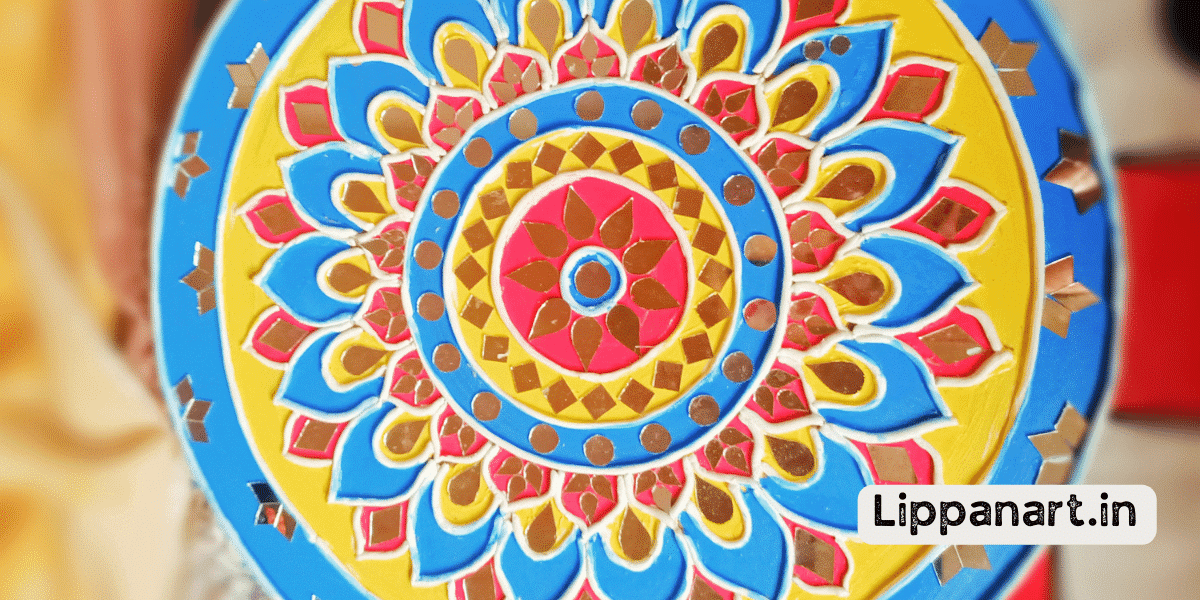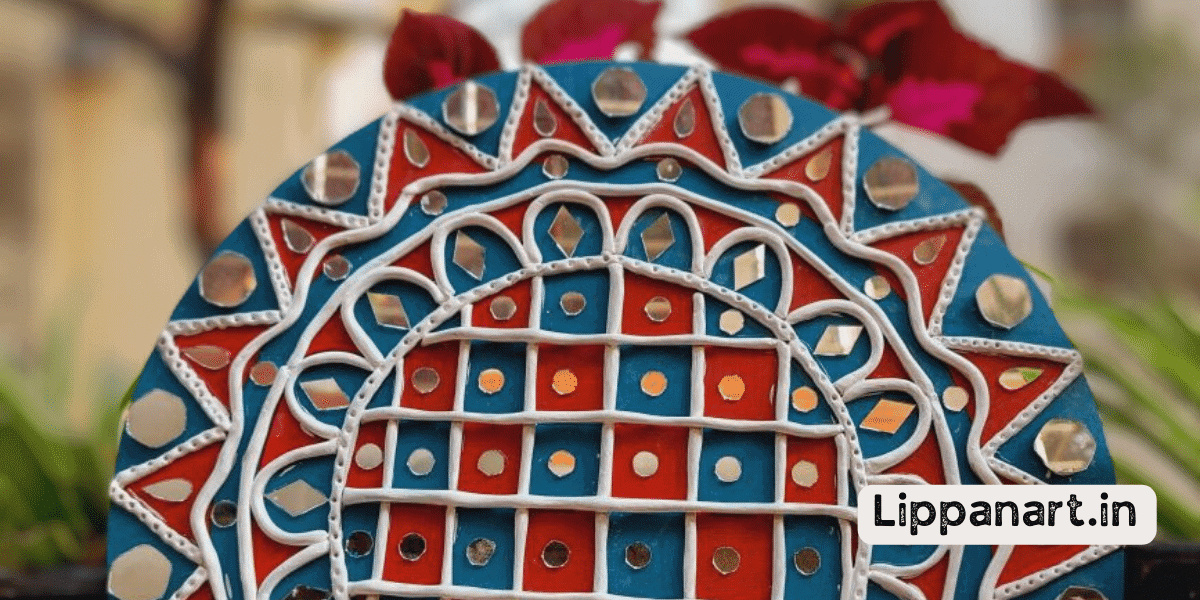Do you want to add a unique touch to your Lippan art designs? Look no further than flowers!
Believe it or not, certain flowers are imbued with cultural significance that can make your art design truly stand out. From lotus to peacock flowers, discover the many flowers with cultural significance for Lippan art designs.
Let’s explore these special flowers and how they can bring innovation to your art designs!
Key Takeaways
- Lotus, marigold, rose, jasmine, tulip, sunflower, and chrysanthemum are flowers with cultural significance in Lippan art designs.
- These flowers symbolize various qualities, such as purity, beauty, love, joy, and prosperity.
- They add vibrant colours, energy, and a sense of positivity to the artwork.
- Flowers like Krishnakamal, mango flower, and Parijat also hold cultural significance and contribute to the cultural identity and beauty of Lippan art designs.

Lotus
You possess a profound appreciation for the lotus, a symbol of purity, beauty, and spiritual awakening. This flower holds an immense amount of cultural significance in Lippan art designs. Its growth symbolism and aesthetics of colour provide a captivating addition to a piece of art.
Many appreciate the scent and symbolism of the lotus, as it continues to be a sacred symbol in many cultures. The Lippan art designs use this flower to convey messages of patience, perseverance, and transformation. They often choose vibrant colours to add vibrancy and energy to the piece. Additionally, the flower is used to represent the spiritual journey and individual growth.
Its symbolism and aesthetics provide a powerful and captivating addition to any piece of art. To fully appreciate the richness of the lotus in Lippan art designs, one must understand the beauty, symbolism, and cultural significance of this flower.
Sunflower
Second on the list of culturally significant flowers for Lippan art designs is the sunflower. A symbol of positivity, joy, and good luck, the sunflower has been used in art in many cultures, including India. Exploring sunflower symbolism and colour meaning in the art can help you create meaningful, innovative Lippan art designs.
The colour yellow of the sunflower is associated with energy, optimism, and clarity. The flower’s spiritual meaning is linked to faith, loyalty, and adoration. Sunflower symbolism in art often represents warmth, strength, positivity, and long life.
In Indian culture, the sunflower has long been associated with the sun god, Surya, and it’s often used to decorate Hindu temples. Sunflowers are also believed to bring luck, abundance, and prosperity. This makes it a perfect choice for bringing positive vibes to a home or business.
The sunflower is a great choice for Lippan art designs because of its spiritual and cultural significance. Its bright yellow colour and its symbolic meaning of loyalty, faith, and adoration make it perfect for creating meaningful and innovative art. With its warm, positive energy, the sunflower will bring good luck and a feeling of joy to any space.
Marigold
Following the sunflower’s symbolism of positivity and luck, the marigold is another flower with great cultural significance for Lippan art designs. Its artistic representation represents joy, peace, and prosperity, having a powerful cultural impact on Indian traditions.
From its vibrant colours to its strong aroma, the marigold is a source of aesthetic appeal. As it’s a symbol of love, marigolds are frequently used in artistic Lippan designs. The amethyst’s symbolic meaning is associated with its healing properties, making it a very popular choice for artistic representations.
The marigold is a representation of the cycle of life, with its petals opening in the morning and closing in the evening. It’s also known for its strong connection to the sun, helping to bring good luck and healing energy.
The marigold’s cultural significance in Lippan art designs is undeniable, with its vibrant colours and symbolic meaning adding beauty and energy to any artwork.
Rose
In addition to the marigold’s symbolism of positivity and luck, the rose is another flower with strong cultural significance for Lippan art designs. With its varied painting techniques, traditional uses, religious symbolism, and regional variations, the rose is a feature of many Lippan art designs.
Its cultural depictions range from traditional to modern, and it’s used to represent love, beauty, courage, and innocence. The rose is often painted with bright colours to create a beautiful landscape or decorative mural. In many cases, the rose is used in the form of a mandala to symbolize protection and spiritual growth.
Traditionally, the rose is used to represent the Hindu goddesses Lakshmi and Parvati. It’s also used to represent the Islamic prophet Muhammad, and it’s believed to bring good luck. Furthermore, the rose is also used to represent various Christian saints and figures.
One can create remarkable pieces of art with different meanings and symbolism using the rose, a flower that possesses great versatility.
Jasmine
Many of the Lippan art designs feature jasmine, a flower that symbolizes purity, grace, and love. Appreciating the beauty and cultural significance of traditional art pieces made from jasmine requires understanding its meaning. Historically, jasmine has been used in various rituals and ceremonies, as it’s believed to have the power to offer protection and bring luck. Generally, it’s also seen as a symbol of purity, beauty, and devotion. The aromatic properties of jasmine are also associated with love, making it a perfect symbol for Lippan art designs.
Apart from its symbolic nature, jasmine also has a lot of practical uses. Its petals are used to make perfumes and oils, while the flowers themselves are often used as a garnish or decoration. In some parts of India, jasmine is also used to decorate temples and other sacred places, as it’s believed to bring good luck and prosperity.
Today, jasmine is still a popular symbol in Lippan art designs. It’s seen as a representation of love, grace, protection, and purity. Moreover, its spiritual and cultural significance make it a perfect symbol for traditional artwork.
Tulip
A tulip is another flower with great cultural significance in Lippan art designs. It’s distinct for its moral significance, being a symbol of love, joy, and hope. In traditional art, tulips were often used to represent happiness and eternal life, and their symbolism is still found in many cultures today.
Tulips can be grown in gardens, with many varieties available to choose from. Some of the most popular varieties include the ‘Red Emperor’ and the ‘White Triumphator,’ which both produce large, vibrant blooms. Tulips can also be found in a variety of shapes and sizes, from the classic cup-shaped petals to the more unusual ‘Parrot’ varieties that feature twisted petals.
The bright colours of tulips make them a popular choice for Lippan art designs. They’re often used to represent joy and happiness, as well as faith and new beginnings. Tulips can also be used in art to express feelings of love and admiration, making them a popular choice for wedding decorations.
No matter the type or colour, tulips are sure to bring a sense of joy and hope to any Lippan art design. With their moral significance and varied uses, tulips are sure to be a favourite choice in traditional art and modern designs alike.
Chrysanthemum
Your Lippan art design can also benefit from the cultural significance of the chrysanthemum, a flower that symbolizes loyalty and joy. This stunning bloom has a long history and many varieties, making it an ideal choice for artistic expression. Depending on the colour, type and design of the chrysanthemum used, it can add a unique touch to any Lippan art piece.
Chrysanthemum symbolism is highly valued in many cultures, and the flower is often used to represent loyalty, joy and optimism. The colour of the chrysanthemum can also be used to convey different meanings. For example, white chrysanthemums are a symbol of truth and honesty, while yellow chrysanthemums symbolize joy and optimism.
There are many varieties of chrysanthemums, each with its own unique characteristics. Many varieties come in different sizes, shapes, and colors, perfect for Lippan art. Additionally, they’re relatively easy to cultivate and can thrive in a variety of climates, allowing for a wide range of possibilities.
Chrysanthemums come in a variety of colours, from bright and bold to subtle and soft. This wide range of colours can be used to create stunning designs on Lippan art. Additionally, chrysanthemums can be used in a variety of ways, from being used as cut flowers or dried flowers to being used in crafting projects.
The chrysanthemum is an ideal flower for adding cultural significance and beauty to any Lippan art design. Its symbolism and wide range of varieties, colours and uses make it a perfect choice for any art project. With the right creativity and vision, chrysanthemums can be used to create unique and stunning art designs that will last for years to come.

Peacock Flower (Krishna Kamal)
You can use the Peacock Flower, also known as Krishnakamal, to add a culturally significant touch to your Lippan art design. Exploring Krishnakamal in Lippan Art is a great way to bring out the beauty of this flower. The symbolic meanings of Krishnakamal are linked to various aspects of Indian culture, making it a great choice for expressing your cultural identity.
Here are some ways you can use Krishna Kamal in your Lippan art:
- Crafting Lippan Art with Krishnakamal: You can use the flowers to create intricate designs or simply use them to add some colour to your art.
- Krishnakamal in Ancient Indian Art: The flower has been used to decorate ancient Indian art for centuries. Use this knowledge to your advantage and create something unique.
- Regional Variations of Krishnakamal: Depending on the region, you can find different varieties of the flower. This can add a nice twist to your art.
Using Krishnakamal in your Lippan art is a great way to express your cultural identity and bring out the beauty of this flower. Be creative and explore the different ways you can use this flower to create something unique and special.
Mango Flower
Adding a cultural touch to your Lippan art design is easy with the Mango Flower, also known as Ambal. The Mango Flower is popular in India and is known for its symbolism, colours, and uses in various cultures.
The mango flower is a symbol of fertility and abundance, and its bright colours are said to bring joy and prosperity. For this reason, it’s often used in crafts and decorations. In Lippan art, the Mango Flower is often used to bring life and beauty to the art design.
The vibrant colours and symbolism of the Mango Flower can be used to create stunning designs. Additionally, the mango flower is used to bring a cultural element to the design, as it’s associated with various cultures and religions.
With its symbolism, colours, and uses, the Mango Flower can be an invaluable addition to any Lippan art design.
Parijat (Night Jasmine)
Featuring its star-shaped petals and sweet scent, Parijat (Night Jasmine) is a flower with cultural significance often used in Lippan art designs. To honour its significance, here are some notable points to consider:
- Ceremonial Significance: Parijat is a symbol of love and devotion and is believed to bring good luck and prosperity. It’s used in traditional ceremonies such as weddings and religious festivals.
- Symbolism in Stories: Parijat is often used as a symbol of immortality and eternity in Indian and Middle Eastern folklore. It’s seen as a symbol of hope and beauty.
- Crafting Techniques: Parijat is used in a variety of crafting techniques, such as printing, weaving, dyeing, and embroidery. It’s also used to create beautiful and intricate designs on garments.
- Medicinal Benefits: Parijat has many medicinal benefits, such as aiding in digestion, relieving headaches, and treating skin disorders.
- Preservation Methods: To preserve Parijat’s beauty and cultural significance, it needs to be properly cared for. Proper storage involves keeping the item in a cool and dry location while also protecting it from sunlight exposure.
Parijat is a beautiful and meaningful flower, and its use in Lippan art designs is a testament to its cultural significance.
Conclusion
You don’t have to be an artist to appreciate the beauty of the flowers used in Lippan art. Their intricate designs and cultural significance make them truly unique and special.
Even if you don’t have the time or skill to make one yourself, you can still appreciate the craftsmanship and beauty of these works.
Don’t let the fear of difficulty prevent you from creating something amazing and unique with a bit of effort.























